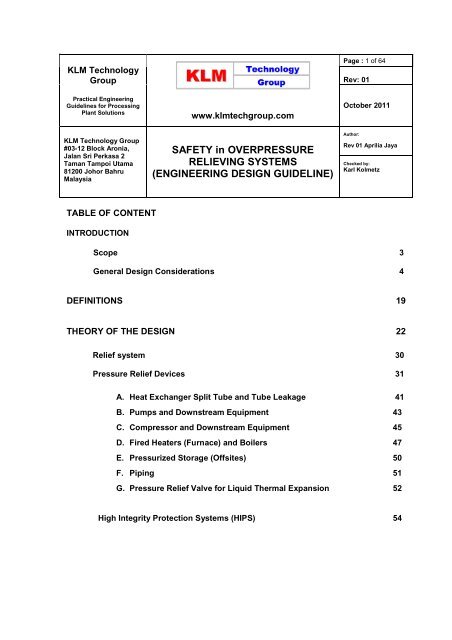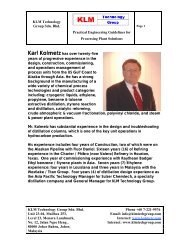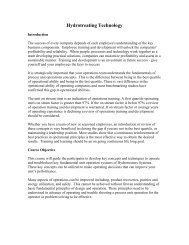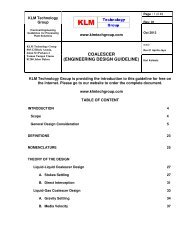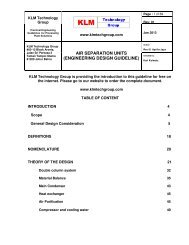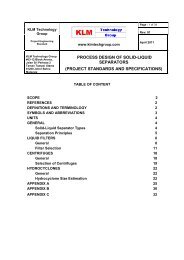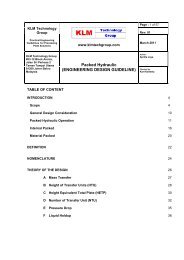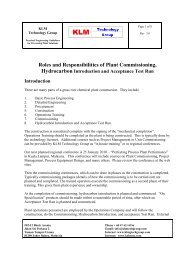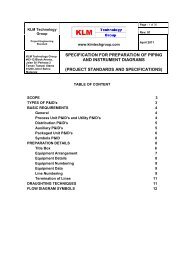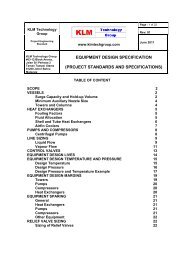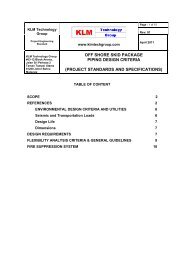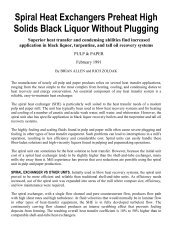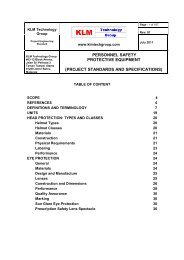SAFETY in OVERPRESSURE RELIEVING SYSTEMS - KLM ...
SAFETY in OVERPRESSURE RELIEVING SYSTEMS - KLM ...
SAFETY in OVERPRESSURE RELIEVING SYSTEMS - KLM ...
- No tags were found...
You also want an ePaper? Increase the reach of your titles
YUMPU automatically turns print PDFs into web optimized ePapers that Google loves.
<strong>KLM</strong> TechnologyGroupPage : 1 of 64Rev: 01Practical Eng<strong>in</strong>eer<strong>in</strong>gGuidel<strong>in</strong>es for Process<strong>in</strong>gPlant Solutionswww.klmtechgroup.comOctober 2011<strong>KLM</strong> Technology Group#03-12 Block Aronia,Jalan Sri Perkasa 2Taman Tampoi Utama81200 Johor BahruMalaysia<strong>SAFETY</strong> <strong>in</strong> <strong>OVERPRESSURE</strong><strong>RELIEVING</strong> <strong>SYSTEMS</strong>(ENGINEERING DESIGN GUIDELINE)Author:Rev 01 Aprilia JayaChecked by:Karl KolmetzTABLE OF CONTENTINTRODUCTIONScope 3General Design Considerations 4DEFINITIONS 19THEORY OF THE DESIGN 22Relief system 30Pressure Relief Devices 31A. Heat Exchanger Split Tube and Tube Leakage 41B. Pumps and Downstream Equipment 43C. Compressor and Downstream Equipment 45D. Fired Heaters (Furnace) and Boilers 47E. Pressurized Storage (Offsites) 50F. Pip<strong>in</strong>g 51G. Pressure Relief Valve for Liquid Thermal Expansion 52High Integrity Protection Systems (HIPS) 54
<strong>KLM</strong> TechnologyGroupPractical Eng<strong>in</strong>eer<strong>in</strong>g Guidel<strong>in</strong>esfor Process<strong>in</strong>g Plant Solutions<strong>SAFETY</strong> <strong>in</strong> <strong>OVERPRESSURE</strong><strong>RELIEVING</strong> <strong>SYSTEMS</strong>ENGINEERING DESIGN GUIDELINESPage 2 of 64Rev: 01October 2011REFEREENCES 61LIST OF TABLETable 1: SIL Level and Related Measure 9Table 2: Possible (simplified) format for Safety Requirement Specification 22Table 3: Comparisons of conventional, bellow and pilot pressure relief valve 38LIST OF FIGUREFigure 1: Safety layers 7Figure 2: Example SIL 1 SIF (a) and High Reliability SIL 1 SIF (b). 9Figure 3: Example SIL 2 SIF (a) and High Reliability SIL 2 SIF (b). 10Figure 4: Example SIL 3 SIF (a) and High Reliability SIL 3 SIF (b). 11Figure 5: Flowchart – SIL development and allocation 12Figure 6: Example of allocation of safety function to protection layers foroverpressure protection 13Figure 7: Basic SIS layout 16Figure 8: The relationship between SIS, SIF and SIL 20Figure 9: SIS safety life-cycle phases 23Figure 10: Conventional pressure relief valve 32Figure 11: Balanced pressure relief valve 33Figure 12: Pilot Operated Relief Valve 36Figure 13: Forward-Act<strong>in</strong>g Solid Metal Rupture Disk Assembly 37Figure 14: Heat exchanger with pressure relief valve to protect form overpressure 42Figure 15: Piston pumps with pressure compensation 44These design guidel<strong>in</strong>e are believed to be as accurate as possible, but are very general and not for specific design cases.They were designed for eng<strong>in</strong>eers to do prelim<strong>in</strong>ary designs and process specification sheets. The f<strong>in</strong>al design mustalways be guaranteed for the service selected by the manufactur<strong>in</strong>g vendor, but these guidel<strong>in</strong>es will greatly reduce theamount of up front eng<strong>in</strong>eer<strong>in</strong>g hours that are required to develop the f<strong>in</strong>al design. The guidel<strong>in</strong>es are a tra<strong>in</strong><strong>in</strong>g tool foryoung eng<strong>in</strong>eers or a resource for eng<strong>in</strong>eers with experience.This document is entrusted to the recipient personally, but the copyright rema<strong>in</strong>s with us. It must not be copied,reproduced or <strong>in</strong> any way communicated or made accessible to third parties without our written consent.
<strong>KLM</strong> TechnologyGroupPractical Eng<strong>in</strong>eer<strong>in</strong>g Guidel<strong>in</strong>esfor Process<strong>in</strong>g Plant Solutions<strong>SAFETY</strong> <strong>in</strong> <strong>OVERPRESSURE</strong><strong>RELIEVING</strong> <strong>SYSTEMS</strong>ENGINEERING DESIGN GUIDELINESPage 3 of 64Rev: 01October 2011Figure 16: Gas compressor 46Figure 17: Fire heaters 49Figure 18: Pressure storage tank 51Figure 19: Two-out-of-three Vot<strong>in</strong>g 55Figure 20: Field Input Devices 56Figure 21: Installation Illustration for F<strong>in</strong>al elements Show<strong>in</strong>g 1oo2 Valves and1oo2 Solenoids 57Picture 22: HIPS Schematic Diagram 61Figure 23: Simplified Decision Tree 62These design guidel<strong>in</strong>e are believed to be as accurate as possible, but are very general and not for specific design cases.They were designed for eng<strong>in</strong>eers to do prelim<strong>in</strong>ary designs and process specification sheets. The f<strong>in</strong>al design mustalways be guaranteed for the service selected by the manufactur<strong>in</strong>g vendor, but these guidel<strong>in</strong>es will greatly reduce theamount of up front eng<strong>in</strong>eer<strong>in</strong>g hours that are required to develop the f<strong>in</strong>al design. The guidel<strong>in</strong>es are a tra<strong>in</strong><strong>in</strong>g tool foryoung eng<strong>in</strong>eers or a resource for eng<strong>in</strong>eers with experience.This document is entrusted to the recipient personally, but the copyright rema<strong>in</strong>s with us. It must not be copied,reproduced or <strong>in</strong> any way communicated or made accessible to third parties without our written consent.
<strong>KLM</strong> TechnologyGroupPractical Eng<strong>in</strong>eer<strong>in</strong>g Guidel<strong>in</strong>esfor Process<strong>in</strong>g Plant Solutions<strong>SAFETY</strong> <strong>in</strong> <strong>OVERPRESSURE</strong><strong>RELIEVING</strong> <strong>SYSTEMS</strong>ENGINEERING DESIGN GUIDELINESPage 4 of 64Rev: 01October 2011INTRODUCTIONScopeThis design guidel<strong>in</strong>e covers the process safety issues <strong>in</strong> overpressure reliev<strong>in</strong>gsystems <strong>in</strong>clud<strong>in</strong>g chemical, petrochemical, and hydrocarbon process<strong>in</strong>g facilities. Thisguidel<strong>in</strong>e assists eng<strong>in</strong>eers to understand the basic design of process safety and<strong>in</strong>creases their knowledge <strong>in</strong> prevention and reduces the risk that an accident may becaused by overpressure.All the important parameters used <strong>in</strong> this guidel<strong>in</strong>e are well expla<strong>in</strong>ed <strong>in</strong> the def<strong>in</strong>itionsection which helps the reader understand the mean<strong>in</strong>g of the parameters and theterms.This design guidel<strong>in</strong>e discusses the method of safety layers like Safety InstrumentedSystem (SIS), Safety Integrity Level (SIL), Safety Instrumented Function (SIF), HighIntegrity Protective System (HIPS), and Pressure Relief Valve (PRV) <strong>in</strong> some equipmentsuch the flare, furnaces, pressure storage, pip<strong>in</strong>g and pumps.In an <strong>in</strong>creas<strong>in</strong>gly multidiscipl<strong>in</strong>ary eng<strong>in</strong>eer<strong>in</strong>g environment, and <strong>in</strong> the face of ever<strong>in</strong>creas<strong>in</strong>g system complexity, there is a grow<strong>in</strong>g need for all eng<strong>in</strong>eers and technicians<strong>in</strong>volved <strong>in</strong> process eng<strong>in</strong>eer<strong>in</strong>g to be aware of the implications of design<strong>in</strong>g andoperat<strong>in</strong>g safety-related systems. This guidel<strong>in</strong>e <strong>in</strong>cludes knowledge of the relevantsafety standards.Safety Instrumented Systems play a vital role <strong>in</strong> provid<strong>in</strong>g the protective layerfunctionality <strong>in</strong> many <strong>in</strong>dustrial process and automation systems. This guidel<strong>in</strong>edescribes the purpose of process safety-related systems <strong>in</strong> general and highlights besteng<strong>in</strong>eer<strong>in</strong>g practice <strong>in</strong> the design and implementation of typical safety <strong>in</strong>strumentedsystems, underp<strong>in</strong>ned by the relevant standards.The design of safety <strong>in</strong> overpressure reliev<strong>in</strong>g system may be <strong>in</strong>fluenced by factors,<strong>in</strong>clud<strong>in</strong>g process requirements, environmental regulations, location, process materials<strong>in</strong>volved, user friendly and economic considerations.These design guidel<strong>in</strong>e are believed to be as accurate as possible, but are very general and not for specific design cases.They were designed for eng<strong>in</strong>eers to do prelim<strong>in</strong>ary designs and process specification sheets. The f<strong>in</strong>al design mustalways be guaranteed for the service selected by the manufactur<strong>in</strong>g vendor, but these guidel<strong>in</strong>es will greatly reduce theamount of up front eng<strong>in</strong>eer<strong>in</strong>g hours that are required to develop the f<strong>in</strong>al design. The guidel<strong>in</strong>es are a tra<strong>in</strong><strong>in</strong>g tool foryoung eng<strong>in</strong>eers or a resource for eng<strong>in</strong>eers with experience.This document is entrusted to the recipient personally, but the copyright rema<strong>in</strong>s with us. It must not be copied,reproduced or <strong>in</strong> any way communicated or made accessible to third parties without our written consent.
<strong>KLM</strong> TechnologyGroupPractical Eng<strong>in</strong>eer<strong>in</strong>g Guidel<strong>in</strong>esfor Process<strong>in</strong>g Plant Solutions<strong>SAFETY</strong> <strong>in</strong> <strong>OVERPRESSURE</strong><strong>RELIEVING</strong> <strong>SYSTEMS</strong>ENGINEERING DESIGN GUIDELINESPage 5 of 64Rev: 01October 2011General Design ConsiderationsNoth<strong>in</strong>g is more important than safety to the process control <strong>in</strong>dustries. Hightemperature and pressure, flammable and toxic materials are just some of the issuesfaced on a daily basis. Reliability is a key component of safety; the more reliable thedevice, the safer the critical process. Compliance with the <strong>in</strong>dustrial standards,ANSI/ISA 84.01-1996 and IEC 61508, requires four essential elements:1. Identification of safety functions required for safe shutdown;2. Assignment of a safety <strong>in</strong>tegrity level (SIL) for each safety function;3. Use of the safety lifecycle for the SIS design; and4. Verification of the SIL achieved for each safety function.Safety Methods employed to protect aga<strong>in</strong>st or mitigate harm/damage to personnel,plant and the environment, and reduce risk <strong>in</strong>clude:1. Chang<strong>in</strong>g the process or eng<strong>in</strong>eer<strong>in</strong>g design2. Increas<strong>in</strong>g mechanical <strong>in</strong>tegrity of the system3. Improv<strong>in</strong>g the Basic Process Control System (BPCS)4. Develop<strong>in</strong>g detailed tra<strong>in</strong><strong>in</strong>g and operational procedures5. Increas<strong>in</strong>g the frequency of test<strong>in</strong>g of critical system components6. Us<strong>in</strong>g a safety Instrumented System (SIS)7. Install<strong>in</strong>g mitigat<strong>in</strong>g equipmentSimplified steps <strong>in</strong> develop<strong>in</strong>g the Safety-related System1. Formulate the conceptual design of the process and def<strong>in</strong>e the overall scope2. Identify process hazards and risks via a hazard analysis and risk assessment3. Identity non-SIS layers of protection4. Determ<strong>in</strong>e the need for additional protection i.e. a SISThese design guidel<strong>in</strong>e are believed to be as accurate as possible, but are very general and not for specific design cases.They were designed for eng<strong>in</strong>eers to do prelim<strong>in</strong>ary designs and process specification sheets. The f<strong>in</strong>al design mustalways be guaranteed for the service selected by the manufactur<strong>in</strong>g vendor, but these guidel<strong>in</strong>es will greatly reduce theamount of up front eng<strong>in</strong>eer<strong>in</strong>g hours that are required to develop the f<strong>in</strong>al design. The guidel<strong>in</strong>es are a tra<strong>in</strong><strong>in</strong>g tool foryoung eng<strong>in</strong>eers or a resource for eng<strong>in</strong>eers with experience.This document is entrusted to the recipient personally, but the copyright rema<strong>in</strong>s with us. It must not be copied,reproduced or <strong>in</strong> any way communicated or made accessible to third parties without our written consent.
<strong>KLM</strong> TechnologyGroupPractical Eng<strong>in</strong>eer<strong>in</strong>g Guidel<strong>in</strong>esfor Process<strong>in</strong>g Plant Solutions<strong>SAFETY</strong> <strong>in</strong> <strong>OVERPRESSURE</strong><strong>RELIEVING</strong> <strong>SYSTEMS</strong>ENGINEERING DESIGN GUIDELINESPage 6 of 64Rev: 01October 2011Where a SIS is identified as be<strong>in</strong>g required…1. Determ<strong>in</strong>e the target SIL (us<strong>in</strong>g qualitative and/or quantitative methods)2. Develop safety requirement specification (SRS)3. Develop SIS conceptual designs to meet SRS4. Install the SIS5. Perform Commission<strong>in</strong>g and pre-startup test<strong>in</strong>g6. Develop operation and ma<strong>in</strong>tenance procedures7. Conduct pre-startup safety review8. Carry out operation and ma<strong>in</strong>tenance of SIS9. Record and re-assess any modification to SIS10.Carry out decommission<strong>in</strong>g procedures at the end of the life of the SIS.No s<strong>in</strong>gle safety measure can elim<strong>in</strong>ate risk and protect a plant and its personnelaga<strong>in</strong>st harm or mitigate the spread of harm if a hazardous <strong>in</strong>cident occurs. For thisreason, safety exists <strong>in</strong> protective layers: a sequence of mechanical devices, processcontrols, shutdown systems and external response measures which prevent or mitigatea hazardous event. If one protection layer fails, successive layers will be available totake the process to a safe state. If one of the protection layers is a safety <strong>in</strong>strumentedfunction (SIF), the risk reduction allocated to it determ<strong>in</strong>es its safety <strong>in</strong>tegrity level (SIL).As the number of protection layers and their reliabilities <strong>in</strong>crease, the safety of theprocess <strong>in</strong>creases.These design guidel<strong>in</strong>e are believed to be as accurate as possible, but are very general and not for specific design cases.They were designed for eng<strong>in</strong>eers to do prelim<strong>in</strong>ary designs and process specification sheets. The f<strong>in</strong>al design mustalways be guaranteed for the service selected by the manufactur<strong>in</strong>g vendor, but these guidel<strong>in</strong>es will greatly reduce theamount of up front eng<strong>in</strong>eer<strong>in</strong>g hours that are required to develop the f<strong>in</strong>al design. The guidel<strong>in</strong>es are a tra<strong>in</strong><strong>in</strong>g tool foryoung eng<strong>in</strong>eers or a resource for eng<strong>in</strong>eers with experience.This document is entrusted to the recipient personally, but the copyright rema<strong>in</strong>s with us. It must not be copied,reproduced or <strong>in</strong> any way communicated or made accessible to third parties without our written consent.
<strong>KLM</strong> TechnologyGroupPractical Eng<strong>in</strong>eer<strong>in</strong>g Guidel<strong>in</strong>esfor Process<strong>in</strong>g Plant Solutions<strong>SAFETY</strong> <strong>in</strong> <strong>OVERPRESSURE</strong><strong>RELIEVING</strong> <strong>SYSTEMS</strong>ENGINEERING DESIGN GUIDELINESPage 7 of 64Rev: 01October 2011Figure 1: Safety layersSafety Integrity Level (SIL)Safety Integrity Level (SIL) is def<strong>in</strong>ed as a relative level of risk-reduction provided by asafety function, or to specify a target level of risk reduction. Safety Integrity Level is away to <strong>in</strong>dicate the tolerable failure rate of a particular safety function. Standards requirethe assignment of a target SIL for any new or retrofitted Safety Instrumented Function(SIF) with<strong>in</strong> the Safety <strong>in</strong>strumented system (SIS). The assignment of the target SIL is adecision requir<strong>in</strong>g the extension of the Hazards Analysis. The SIL assignment is basedon the amount of risk reduction that is necessary to ma<strong>in</strong>ta<strong>in</strong> the risk at an acceptablelevel. All of the SIS design, operation and ma<strong>in</strong>tenance choices must then be verifiedaga<strong>in</strong>st the target SIL. This ensures that the SIS can mitigate the assigned process risk.It is at the heart of acceptable SIS design and <strong>in</strong>cludes the follow<strong>in</strong>g factors:1. Device <strong>in</strong>tegrity2. Diagnostics3. Systematic and common cause failures4. Test<strong>in</strong>g5. Operation6. Ma<strong>in</strong>tenanceSIL is def<strong>in</strong>ed as four discrete levels of safety (1-4). Each level represents an order ofmagnitude of risk reduction. The higher SIL level, the greater the impact of a failure andthe lower the failure rate that is acceptable. Standards require the assignment of a targetSIL for any new or retrofitted SIF with<strong>in</strong> the SIS. The assignment of the target SIL is adecision requir<strong>in</strong>g the extension of the Hazards Analysis. The SIL assignment is basedon the amount of risk reduction that is necessary to ma<strong>in</strong>ta<strong>in</strong> the risk at an acceptablelevel. All of the SIS design, operation and ma<strong>in</strong>tenance choices must then be verifiedaga<strong>in</strong>st the target SILThese design guidel<strong>in</strong>e are believed to be as accurate as possible, but are very general and not for specific design cases.They were designed for eng<strong>in</strong>eers to do prelim<strong>in</strong>ary designs and process specification sheets. The f<strong>in</strong>al design mustalways be guaranteed for the service selected by the manufactur<strong>in</strong>g vendor, but these guidel<strong>in</strong>es will greatly reduce theamount of up front eng<strong>in</strong>eer<strong>in</strong>g hours that are required to develop the f<strong>in</strong>al design. The guidel<strong>in</strong>es are a tra<strong>in</strong><strong>in</strong>g tool foryoung eng<strong>in</strong>eers or a resource for eng<strong>in</strong>eers with experience.This document is entrusted to the recipient personally, but the copyright rema<strong>in</strong>s with us. It must not be copied,reproduced or <strong>in</strong> any way communicated or made accessible to third parties without our written consent.
<strong>KLM</strong> TechnologyGroupPractical Eng<strong>in</strong>eer<strong>in</strong>g Guidel<strong>in</strong>esfor Process<strong>in</strong>g Plant Solutions<strong>SAFETY</strong> <strong>in</strong> <strong>OVERPRESSURE</strong><strong>RELIEVING</strong> <strong>SYSTEMS</strong>ENGINEERING DESIGN GUIDELINESPage 8 of 64Rev: 01October 2011The claimed SIL is limited by the calculated Probability of Failure on Demand (PFD) andRisk Reduction Factor (RRF). When the hazards identification and risk assessmentphase concludes that a SIS is required, the level of risk reduction afforded by the SISand the target SIL have to be assigned.Various methodologies are used for assignment of target SILs. The determ<strong>in</strong>ation must<strong>in</strong>volve people with the relevant expertise and experience. Methodologies used fordeterm<strong>in</strong><strong>in</strong>g SIL <strong>in</strong>clude Simplified Calculations, Fault Tree Analysis, Layer of ProtectionAnalysis (LOPA) and Markov Analysis.There are several problems <strong>in</strong>herent <strong>in</strong> the use of Safety Integrity Levels. These can besummarized as follows.Poor harmonization of def<strong>in</strong>ition across the different standards bodies whichutilize SILProcess-oriented metrics for derivation of SILEstimation of SIL based on reliability estimatesSystem complexity, particularly <strong>in</strong> software systems, mak<strong>in</strong>g SIL estimationdifficult to impossibleTable 1: SIL Level and Related MeasureSIL Availability Range ofAverage PFD4321>99.99%99.9%99 to 99.9%90 to 99%10 -5 to 10 -4Range of RRF100,000 to10,00010 -4 to 10 -3 10,000 to 1,00010 -3 to 10 -2 1,000 to 10010 -2 to 10 -1 100 to 10Qualitative ConsequencePotential for fatalities <strong>in</strong> the communityPotential for multiple on-site fatalitiesPotential for major on-site <strong>in</strong>juries or a fatalityPotential for m<strong>in</strong>or on-site <strong>in</strong>juriesSIL 1In a simple <strong>in</strong>dependent SIL 1 SIF (figure 2a), a s<strong>in</strong>gle sensor is used to detect thepressure. The logic solver de-energizes a solenoid operated valve (SOV) remov<strong>in</strong>g airfrom the valve actuator, allow<strong>in</strong>g the valve to go to its specified failed closed (FC)position. A higher reliability (low spurious trip rate) SIL 1 design (Figure 2b) byimplement<strong>in</strong>g 2oo2 vot<strong>in</strong>g for the sensor and SOV. 2oo2 vot<strong>in</strong>g SOVs have beenThese design guidel<strong>in</strong>e are believed to be as accurate as possible, but are very general and not for specific design cases.They were designed for eng<strong>in</strong>eers to do prelim<strong>in</strong>ary designs and process specification sheets. The f<strong>in</strong>al design mustalways be guaranteed for the service selected by the manufactur<strong>in</strong>g vendor, but these guidel<strong>in</strong>es will greatly reduce theamount of up front eng<strong>in</strong>eer<strong>in</strong>g hours that are required to develop the f<strong>in</strong>al design. The guidel<strong>in</strong>es are a tra<strong>in</strong><strong>in</strong>g tool foryoung eng<strong>in</strong>eers or a resource for eng<strong>in</strong>eers with experience.This document is entrusted to the recipient personally, but the copyright rema<strong>in</strong>s with us. It must not be copied,reproduced or <strong>in</strong> any way communicated or made accessible to third parties without our written consent.
<strong>KLM</strong> TechnologyGroupPractical Eng<strong>in</strong>eer<strong>in</strong>g Guidel<strong>in</strong>esfor Process<strong>in</strong>g Plant Solutions<strong>SAFETY</strong> <strong>in</strong> <strong>OVERPRESSURE</strong><strong>RELIEVING</strong> <strong>SYSTEMS</strong>ENGINEERING DESIGN GUIDELINESPage 9 of 64Rev: 01October 2011proven through decades of use to achieve high <strong>in</strong>tegrity and reliability when <strong>in</strong>strumentair quality is good and the SOVs are properly ma<strong>in</strong>ta<strong>in</strong>ed.1oo12oo2PTPTPTFCFC(a)(b)Figure 2: Example SIL 1 SIF (a) and High Reliability SIL 1 SIF (b).SIL 2Simplex pressure transmitters can be used <strong>in</strong> SIL 2, given a reasonable test <strong>in</strong>terval andthe use of good quality equipment. Figure 3a provides an SIL 2 SIF with an option to usean additional block valve or to share the control valve as a second means of processisolation. The control valve cannot be used, unless it fully meets the SIS design basis(e.g., <strong>in</strong>tegrity, <strong>in</strong>dependence, leak tightness, response time, etc.). Figure 3b provides ahigher reliability SIL 2 design us<strong>in</strong>g 2oo2 vot<strong>in</strong>g sensors and SOVs.1oo1PTThese design guidel<strong>in</strong>e are believed to be as accurate as possible, but are very general and not for specific design cases.They were designed for eng<strong>in</strong>eers to do prelim<strong>in</strong>ary designs and process specification sheets. The f<strong>in</strong>al design mustalways be guaranteed for the service selected by the manufactur<strong>in</strong>g vendor, but these guidel<strong>in</strong>es will greatly reduce theamount of up front eng<strong>in</strong>eer<strong>in</strong>g hours that are required to develop the f<strong>in</strong>al design. The guidel<strong>in</strong>es are a tra<strong>in</strong><strong>in</strong>g tool foryoung eng<strong>in</strong>eers or a resource for eng<strong>in</strong>eers with experience.This document is entrusted to the recipient personally, but the copyright rema<strong>in</strong>s with us. It must not be copied,reproduced or <strong>in</strong> any way communicated or made accessible to third parties without our written consent.
<strong>KLM</strong> TechnologyGroupPractical Eng<strong>in</strong>eer<strong>in</strong>g Guidel<strong>in</strong>esfor Process<strong>in</strong>g Plant Solutions<strong>SAFETY</strong> <strong>in</strong> <strong>OVERPRESSURE</strong><strong>RELIEVING</strong> <strong>SYSTEMS</strong>ENGINEERING DESIGN GUIDELINESPage 10 of 64Rev: 01October 2011ORFC FC FC(a)2oo2PTPTORFC FC FC(b)Figure 3: Example SIL 2 SIF (a) and High Reliability SIL 2 SIF (b).These design guidel<strong>in</strong>e are believed to be as accurate as possible, but are very general and not for specific design cases.They were designed for eng<strong>in</strong>eers to do prelim<strong>in</strong>ary designs and process specification sheets. The f<strong>in</strong>al design mustalways be guaranteed for the service selected by the manufactur<strong>in</strong>g vendor, but these guidel<strong>in</strong>es will greatly reduce theamount of up front eng<strong>in</strong>eer<strong>in</strong>g hours that are required to develop the f<strong>in</strong>al design. The guidel<strong>in</strong>es are a tra<strong>in</strong><strong>in</strong>g tool foryoung eng<strong>in</strong>eers or a resource for eng<strong>in</strong>eers with experience.This document is entrusted to the recipient personally, but the copyright rema<strong>in</strong>s with us. It must not be copied,reproduced or <strong>in</strong> any way communicated or made accessible to third parties without our written consent.
<strong>KLM</strong> TechnologyGroupPractical Eng<strong>in</strong>eer<strong>in</strong>g Guidel<strong>in</strong>esfor Process<strong>in</strong>g Plant Solutions<strong>SAFETY</strong> <strong>in</strong> <strong>OVERPRESSURE</strong><strong>RELIEVING</strong> <strong>SYSTEMS</strong>ENGINEERING DESIGN GUIDELINESPage 11 of 64Rev: 01October 2011SIL 3SIL 3 is the highest level of performance typically expected from an SIF <strong>in</strong> the process<strong>in</strong>dustry. For SIL 3, systematic errors must be m<strong>in</strong>imized through the use of faulttolerance. Fault tolerance must be provided <strong>in</strong> the sensors, logic solver, f<strong>in</strong>al elements,and any required support systems. Figure 4a provides an SIL 3 architecture that is faulttolerant aga<strong>in</strong>st dangerous failures us<strong>in</strong>g 1oo2 vot<strong>in</strong>g sensors and dedicated blockvalves. Figure 4b provides a high reliability SIL 3 architecture us<strong>in</strong>g 2oo3 vot<strong>in</strong>g sensorsand 2oo2 SOVs.1oo2PTPT(a)FCFC2oo3PTPTPT(b)FCFCFigure 4: Example SIL 3 SIF (a) and High Reliability SIL 3 SIF (b).These design guidel<strong>in</strong>e are believed to be as accurate as possible, but are very general and not for specific design cases.They were designed for eng<strong>in</strong>eers to do prelim<strong>in</strong>ary designs and process specification sheets. The f<strong>in</strong>al design mustalways be guaranteed for the service selected by the manufactur<strong>in</strong>g vendor, but these guidel<strong>in</strong>es will greatly reduce theamount of up front eng<strong>in</strong>eer<strong>in</strong>g hours that are required to develop the f<strong>in</strong>al design. The guidel<strong>in</strong>es are a tra<strong>in</strong><strong>in</strong>g tool foryoung eng<strong>in</strong>eers or a resource for eng<strong>in</strong>eers with experience.This document is entrusted to the recipient personally, but the copyright rema<strong>in</strong>s with us. It must not be copied,reproduced or <strong>in</strong> any way communicated or made accessible to third parties without our written consent.
<strong>KLM</strong> TechnologyGroupPractical Eng<strong>in</strong>eer<strong>in</strong>g Guidel<strong>in</strong>esfor Process<strong>in</strong>g Plant Solutions<strong>SAFETY</strong> <strong>in</strong> <strong>OVERPRESSURE</strong><strong>RELIEVING</strong> <strong>SYSTEMS</strong>ENGINEERING DESIGN GUIDELINESPage 12 of 64Rev: 01October 2011EUC Def<strong>in</strong>itionHazard andrisk analysisDef<strong>in</strong>ition ofsafety functionsApply table withrecommended SILrequirementsHave safety functionsfor which SIL table isnot applicable beenidentifiedNoPerform SILallocationYesFor each identified:apply risk basedmethodology forSIL determ<strong>in</strong>ationDevelop safetyfunctions requirementsspecificationProvide <strong>in</strong>put to SISdesign and eng<strong>in</strong>eer<strong>in</strong>gFigure 5: Flowchart – SIL development and allocationThese design guidel<strong>in</strong>e are believed to be as accurate as possible, but are very general and not for specific design cases.They were designed for eng<strong>in</strong>eers to do prelim<strong>in</strong>ary designs and process specification sheets. The f<strong>in</strong>al design mustalways be guaranteed for the service selected by the manufactur<strong>in</strong>g vendor, but these guidel<strong>in</strong>es will greatly reduce theamount of up front eng<strong>in</strong>eer<strong>in</strong>g hours that are required to develop the f<strong>in</strong>al design. The guidel<strong>in</strong>es are a tra<strong>in</strong><strong>in</strong>g tool foryoung eng<strong>in</strong>eers or a resource for eng<strong>in</strong>eers with experience.This document is entrusted to the recipient personally, but the copyright rema<strong>in</strong>s with us. It must not be copied,reproduced or <strong>in</strong> any way communicated or made accessible to third parties without our written consent.
<strong>KLM</strong> TechnologyGroupPractical Eng<strong>in</strong>eer<strong>in</strong>g Guidel<strong>in</strong>esfor Process<strong>in</strong>g Plant Solutions<strong>SAFETY</strong> <strong>in</strong> <strong>OVERPRESSURE</strong><strong>RELIEVING</strong> <strong>SYSTEMS</strong>ENGINEERING DESIGN GUIDELINESPage 13 of 64Rev: 01October 2011If the required SIL cannot be achieved with the <strong>in</strong>itial design, some options are:1. More frequent proof test<strong>in</strong>g2. Add redundancy (i.e., <strong>in</strong>itiat<strong>in</strong>g device, control system, f<strong>in</strong>al element)3. Install “smarter” device (i.e., HART smart transmitter or transmitter vs. switch orrelay, smart control valve with diagnostics and feedback and position <strong>in</strong>dicationvs. basic control valve)4. Add protection layers (<strong>in</strong>dependent)Residual riskAcceptable risk(frequency ofoverpressure)Frequency ofoverpressure forequipment w/oprotection (EUC risk)1 x 10 -5 per year5 per yearRequired risk reductionIncreasedfrequency ofoverpressureActual risk reductionRisk reductionfrom manuallyactivated ESD(~ 0.1)Riskreductionfrom PSV(SIL 1)Riskreduction ofPSD(SIL 1)Riskreductionfrom HIPS(SIL 3)Achievable risk reduction from all safety functionsFigure 6: Example of allocation of safety function to protection layers for overpressureprotectionThese design guidel<strong>in</strong>e are believed to be as accurate as possible, but are very general and not for specific design cases.They were designed for eng<strong>in</strong>eers to do prelim<strong>in</strong>ary designs and process specification sheets. The f<strong>in</strong>al design mustalways be guaranteed for the service selected by the manufactur<strong>in</strong>g vendor, but these guidel<strong>in</strong>es will greatly reduce theamount of up front eng<strong>in</strong>eer<strong>in</strong>g hours that are required to develop the f<strong>in</strong>al design. The guidel<strong>in</strong>es are a tra<strong>in</strong><strong>in</strong>g tool foryoung eng<strong>in</strong>eers or a resource for eng<strong>in</strong>eers with experience.This document is entrusted to the recipient personally, but the copyright rema<strong>in</strong>s with us. It must not be copied,reproduced or <strong>in</strong> any way communicated or made accessible to third parties without our written consent.
<strong>KLM</strong> TechnologyGroupPractical Eng<strong>in</strong>eer<strong>in</strong>g Guidel<strong>in</strong>esfor Process<strong>in</strong>g Plant Solutions<strong>SAFETY</strong> <strong>in</strong> <strong>OVERPRESSURE</strong><strong>RELIEVING</strong> <strong>SYSTEMS</strong>ENGINEERING DESIGN GUIDELINESPage 14 of 64Rev: 01October 2011The SIL is affected by the follow<strong>in</strong>g:1. Device <strong>in</strong>tegrity determ<strong>in</strong>ed by documented and supportable failure rates;2. Redundancy and vot<strong>in</strong>g us<strong>in</strong>g multiple devices to ensure fault tolerance;3. Functional test<strong>in</strong>g at specific <strong>in</strong>tervals to determ<strong>in</strong>e that the device can achievethe fail safe condition;4. Diagnostic coverage us<strong>in</strong>g automatic or on-l<strong>in</strong>e methods to detect device failure;5. Other common causes <strong>in</strong>clud<strong>in</strong>g those related to the device, design, systematicfaults, <strong>in</strong>stallation, and human error.Safety Instrumented System (SIS)A safety <strong>in</strong>strumented system (SIS) is a system compris<strong>in</strong>g sensors, logic solvers andactuators for the purposes of tak<strong>in</strong>g a process to a safe state when normalpredeterm<strong>in</strong>ed set po<strong>in</strong>ts are exceeded, or safe operat<strong>in</strong>g conditions are violated suchas set po<strong>in</strong>ts for pressure, temperature, level, etc. <strong>in</strong> other words, they trip the processwhen they out of limit condition. SIS are also called emergency shutdown (ESD)systems, safety shutdown (SSD) systems, and safety <strong>in</strong>terlock systems.The scope of a SIS encompasses all <strong>in</strong>strumentation and controls that are responsiblefor br<strong>in</strong>g<strong>in</strong>g a process to a safe state <strong>in</strong> the event of an unacceptable deviation or failure.SIS provides a layer of protection to help protect the process aga<strong>in</strong>st accidents. Thebasic SIS layout comprises:1. Sensor(s) for signal <strong>in</strong>put and power2. Input signal <strong>in</strong>terfac<strong>in</strong>g and process<strong>in</strong>g3. Logic solver with associated communications and power. The safety firmwareconstitutes the basic logic solver equipment from which the safety applicationsare built:a. Framework, racks, cab<strong>in</strong>ets;b. Processor/memory boards;c. Communication boards;d. I/O boards;e. Term<strong>in</strong>ation units;These design guidel<strong>in</strong>e are believed to be as accurate as possible, but are very general and not for specific design cases.They were designed for eng<strong>in</strong>eers to do prelim<strong>in</strong>ary designs and process specification sheets. The f<strong>in</strong>al design mustalways be guaranteed for the service selected by the manufactur<strong>in</strong>g vendor, but these guidel<strong>in</strong>es will greatly reduce theamount of up front eng<strong>in</strong>eer<strong>in</strong>g hours that are required to develop the f<strong>in</strong>al design. The guidel<strong>in</strong>es are a tra<strong>in</strong><strong>in</strong>g tool foryoung eng<strong>in</strong>eers or a resource for eng<strong>in</strong>eers with experience.This document is entrusted to the recipient personally, but the copyright rema<strong>in</strong>s with us. It must not be copied,reproduced or <strong>in</strong> any way communicated or made accessible to third parties without our written consent.
<strong>KLM</strong> TechnologyGroupPractical Eng<strong>in</strong>eer<strong>in</strong>g Guidel<strong>in</strong>esfor Process<strong>in</strong>g Plant Solutions<strong>SAFETY</strong> <strong>in</strong> <strong>OVERPRESSURE</strong><strong>RELIEVING</strong> <strong>SYSTEMS</strong>ENGINEERING DESIGN GUIDELINESPage 15 of 64Rev: 01October 2011f. Power supplies;g. System software;h. Application software libraries;i. Application programm<strong>in</strong>g tools;j. Communication protocols;k. Human/system <strong>in</strong>terfaces.When design<strong>in</strong>g the logic solver hardware, the follow<strong>in</strong>g should be taken <strong>in</strong>toaccount:a. A safety user design manual should exist which describes how noncertifiedequipment shall be used <strong>in</strong> safety critical applications. For certifiedequipment this is normally available as part of the certification;b. Appropriate designated architecture must be selected for the centralprocess<strong>in</strong>g unit. As a m<strong>in</strong>imum, the selected architecture shall meet thehighest SIL level of the relevant safety functions;c. If possible, the architecture of the I/O and <strong>in</strong>terface modules should beselected <strong>in</strong>dividually for each safety function;d. When work<strong>in</strong>g with certified equipment, the difference between certifiedcomponents and components certified for non-<strong>in</strong>terference should benoted:e. Certified components: for use <strong>in</strong> safety critical functions;f. Components certified for non-<strong>in</strong>terference: may be used but not <strong>in</strong> safetycritical functions.g. For non-certified equipment PFD calculations shall be performed to showthat the contribution from the logic solver is with<strong>in</strong> acceptable limits;h. For certified equipment the maximum contribution to the PFD figure isnormally part of the certification report and is therefore available as precalculatedand verified parameters;i. For non-certified equipment the maximum time <strong>in</strong> degraded mode shouldbe calculated;j. For certified equipment the maximum time <strong>in</strong> degraded mode is normallypart of the certification report and is therefore available as pre-calculatedand verified parameters.These design guidel<strong>in</strong>e are believed to be as accurate as possible, but are very general and not for specific design cases.They were designed for eng<strong>in</strong>eers to do prelim<strong>in</strong>ary designs and process specification sheets. The f<strong>in</strong>al design mustalways be guaranteed for the service selected by the manufactur<strong>in</strong>g vendor, but these guidel<strong>in</strong>es will greatly reduce theamount of up front eng<strong>in</strong>eer<strong>in</strong>g hours that are required to develop the f<strong>in</strong>al design. The guidel<strong>in</strong>es are a tra<strong>in</strong><strong>in</strong>g tool foryoung eng<strong>in</strong>eers or a resource for eng<strong>in</strong>eers with experience.This document is entrusted to the recipient personally, but the copyright rema<strong>in</strong>s with us. It must not be copied,reproduced or <strong>in</strong> any way communicated or made accessible to third parties without our written consent.
<strong>KLM</strong> TechnologyGroupPractical Eng<strong>in</strong>eer<strong>in</strong>g Guidel<strong>in</strong>esfor Process<strong>in</strong>g Plant Solutions<strong>SAFETY</strong> <strong>in</strong> <strong>OVERPRESSURE</strong><strong>RELIEVING</strong> <strong>SYSTEMS</strong>ENGINEERING DESIGN GUIDELINESPage 16 of 64Rev: 01October 20114. Output signal process<strong>in</strong>g, <strong>in</strong>terfac<strong>in</strong>g and power5. Actuators and valve(s) or switch<strong>in</strong>g devices to provide the f<strong>in</strong>al control elementfunction.Input InterfacesCommunicationsOutput InterfacesInputsensorsInput<strong>in</strong>terfacesE/E/PE DeviceOutput<strong>in</strong>terfacesOutputsignalsOutputactuators/ f<strong>in</strong>alcontrolelementsPower SuppliesValveFigure 7: Basic SIS layoutSafety Instrumented System (SIS) is an alternative for conventional relief device toelim<strong>in</strong>ate the source of overpressure, thereby mak<strong>in</strong>g relief capacity unnecessary. Theyare typically used where the provision of relief capacity is <strong>in</strong>appropriate. This is typically(but not always) due to one of the follow<strong>in</strong>g factors:1. The fluid which would be discharged via a reliev<strong>in</strong>g device is toxic or extremelyhazardous2. Realistic evaluation of the overpressure scenario and quantification of the reliefload is difficult or impossible (e.g. explosive reaction)3. The cost of provid<strong>in</strong>g the necessary capacity <strong>in</strong> the disposal system or the reliefvalves is prohibitive.4. The vessel is not exclusively <strong>in</strong> air, water, or steam service.5. The user must ensure the MAWP of the vessel is higher than the highestpressure that can reasonably be achieved by the system.These design guidel<strong>in</strong>e are believed to be as accurate as possible, but are very general and not for specific design cases.They were designed for eng<strong>in</strong>eers to do prelim<strong>in</strong>ary designs and process specification sheets. The f<strong>in</strong>al design mustalways be guaranteed for the service selected by the manufactur<strong>in</strong>g vendor, but these guidel<strong>in</strong>es will greatly reduce theamount of up front eng<strong>in</strong>eer<strong>in</strong>g hours that are required to develop the f<strong>in</strong>al design. The guidel<strong>in</strong>es are a tra<strong>in</strong><strong>in</strong>g tool foryoung eng<strong>in</strong>eers or a resource for eng<strong>in</strong>eers with experience.This document is entrusted to the recipient personally, but the copyright rema<strong>in</strong>s with us. It must not be copied,reproduced or <strong>in</strong> any way communicated or made accessible to third parties without our written consent.
<strong>KLM</strong> TechnologyGroupPractical Eng<strong>in</strong>eer<strong>in</strong>g Guidel<strong>in</strong>esfor Process<strong>in</strong>g Plant Solutions<strong>SAFETY</strong> <strong>in</strong> <strong>OVERPRESSURE</strong><strong>RELIEVING</strong> <strong>SYSTEMS</strong>ENGINEERING DESIGN GUIDELINESPage 17 of 64Rev: 01October 20116. A quantitative or qualitative risk analysis of the proposed system must be madeaddress<strong>in</strong>g: credible overpressure scenarios, demonstrat<strong>in</strong>g the proposed systemis <strong>in</strong>dependent of the potential causes for overpressure; is as reliable as thepressure relief device it replaces; and is capable of completely mitigat<strong>in</strong>g theoverpressure event.Lifecycle of SIS is based on IEC 61511. IEC 61511 covers a wide range of chemicalprocess operations. Due to its broad scope, the standard has many generalrequirements address<strong>in</strong>g the complete lifecycle of the SIS, start<strong>in</strong>g with the identificationof SIS requirements <strong>in</strong> the risk assessment and end<strong>in</strong>g when the SIS isdecommissioned. While there are many different ways of represent<strong>in</strong>g the lifecycle, asimple four step approach can be followed:1. Def<strong>in</strong>e a risk-management strategy - establish a facility management system forhow SISs are identified, designed, <strong>in</strong>spected, ma<strong>in</strong>ta<strong>in</strong>ed, tested, and operated toachieve safe operation and perform a hazard and risk analysis to identify whereSISs are needed and their target SIL2. Implement the strategy - develop a design basis to achieve the target SIL andexecute the detailed design to meet the requirements. The SIS design basisshould address the follow<strong>in</strong>g:a. Detection of and response to potential hazardous eventsb. Selection of equipment based on prior historyc. Fault detection, such as diagnostics and proof test<strong>in</strong>gd. Fault tolerance aga<strong>in</strong>st dangerous failurese. Procedures for ma<strong>in</strong>tenance and test, <strong>in</strong>clud<strong>in</strong>g the use of bypassesf. Operation and ma<strong>in</strong>tenance procedures required when SIS equipment isout of serviceg. Emergency shutdown capability if the SIS fails to take action as expectedh. Start-up and shutdown of the process equipmentThese design guidel<strong>in</strong>e are believed to be as accurate as possible, but are very general and not for specific design cases.They were designed for eng<strong>in</strong>eers to do prelim<strong>in</strong>ary designs and process specification sheets. The f<strong>in</strong>al design mustalways be guaranteed for the service selected by the manufactur<strong>in</strong>g vendor, but these guidel<strong>in</strong>es will greatly reduce theamount of up front eng<strong>in</strong>eer<strong>in</strong>g hours that are required to develop the f<strong>in</strong>al design. The guidel<strong>in</strong>es are a tra<strong>in</strong><strong>in</strong>g tool foryoung eng<strong>in</strong>eers or a resource for eng<strong>in</strong>eers with experience.This document is entrusted to the recipient personally, but the copyright rema<strong>in</strong>s with us. It must not be copied,reproduced or <strong>in</strong> any way communicated or made accessible to third parties without our written consent.
<strong>KLM</strong> TechnologyGroupPractical Eng<strong>in</strong>eer<strong>in</strong>g Guidel<strong>in</strong>esfor Process<strong>in</strong>g Plant Solutions<strong>SAFETY</strong> <strong>in</strong> <strong>OVERPRESSURE</strong><strong>RELIEVING</strong> <strong>SYSTEMS</strong>ENGINEERING DESIGN GUIDELINESPage 18 of 64Rev: 01October 20113. Validate, start-up, operate and ma<strong>in</strong>ta<strong>in</strong> the strategy - implement the SISfollow<strong>in</strong>g the design basis and detailed design documentation and def<strong>in</strong>e what isrequired of operation and ma<strong>in</strong>tenance personnel to susta<strong>in</strong> the SIL4. Manage changes to the strategy - ensure the SIS meets the target SIL bymonitor<strong>in</strong>g operation, <strong>in</strong>spection, test, and ma<strong>in</strong>tenance records and mak<strong>in</strong>gchanges as necessary to improve its performanceValidation plann<strong>in</strong>g of the SIS should def<strong>in</strong>e all activities required for validation. Thefollow<strong>in</strong>g items shall be <strong>in</strong>cluded:1. The validation activities, <strong>in</strong>clud<strong>in</strong>g validation of the SIS with respect to the safetyrequirements specification and implementation and resolution of result<strong>in</strong>grecommendations;2. Validation of all relevant modes of operation of the process and its associatedequipment <strong>in</strong>clud<strong>in</strong>g:a. Preparation for use <strong>in</strong>clud<strong>in</strong>g sett<strong>in</strong>g and adjustment;b. Start-up, teach, automatic, manual, semi-automatic and steady state ofoperation;c. Re-sett<strong>in</strong>g, shut down and ma<strong>in</strong>tenance;d. Reasonably foreseeable abnormal conditions.3. The procedures, measures and techniques to be used for validation;4. Reference to <strong>in</strong>formation aga<strong>in</strong>st which the validation shall be carried out (e.g.,cause and effect chart, system control diagrams).5. When the activities shall take place;6. The persons, departments and organizations responsible for the activities andlevels of <strong>in</strong>dependence for validation activities;SIS safety validation shall mean all necessary activities to validate that the <strong>in</strong>stalled andmechanical completed SIS and its associated <strong>in</strong>strumented functions, meets therequirements as stated <strong>in</strong> the Safety Requirement Specification (SRS). The validation ofthe safety <strong>in</strong>strumented system and its associated safety <strong>in</strong>strumented functions shall becarried out <strong>in</strong> accordance with the safety <strong>in</strong>strumented system validation plann<strong>in</strong>g.Validation activities shall as a m<strong>in</strong>imum confirm that:These design guidel<strong>in</strong>e are believed to be as accurate as possible, but are very general and not for specific design cases.They were designed for eng<strong>in</strong>eers to do prelim<strong>in</strong>ary designs and process specification sheets. The f<strong>in</strong>al design mustalways be guaranteed for the service selected by the manufactur<strong>in</strong>g vendor, but these guidel<strong>in</strong>es will greatly reduce theamount of up front eng<strong>in</strong>eer<strong>in</strong>g hours that are required to develop the f<strong>in</strong>al design. The guidel<strong>in</strong>es are a tra<strong>in</strong><strong>in</strong>g tool foryoung eng<strong>in</strong>eers or a resource for eng<strong>in</strong>eers with experience.This document is entrusted to the recipient personally, but the copyright rema<strong>in</strong>s with us. It must not be copied,reproduced or <strong>in</strong> any way communicated or made accessible to third parties without our written consent.
<strong>KLM</strong> TechnologyGroupPractical Eng<strong>in</strong>eer<strong>in</strong>g Guidel<strong>in</strong>esfor Process<strong>in</strong>g Plant Solutions<strong>SAFETY</strong> <strong>in</strong> <strong>OVERPRESSURE</strong><strong>RELIEVING</strong> <strong>SYSTEMS</strong>ENGINEERING DESIGN GUIDELINESPage 19 of 64Rev: 01October 20111. The safety <strong>in</strong>strumented system performs under normal and abnormal operat<strong>in</strong>gmodes (e.g., start-up, shutdown, etc.) as identified <strong>in</strong> the Safety RequirementSpecification;2. Adverse <strong>in</strong>teraction of the basic process control system and other connectedsystems do not affect the proper operation of the safety <strong>in</strong>strumented system;3. The safety <strong>in</strong>strumented system properly communicates (where required) with thebasic process control system or any other system or network;4. Sensors, logic solver, and f<strong>in</strong>al elements perform <strong>in</strong> accordance with the safetyrequirement specification, <strong>in</strong>clud<strong>in</strong>g all redundant channels;5. Safety <strong>in</strong>strumented system documentation reflects the <strong>in</strong>stalled system;6. The safety <strong>in</strong>strumented function performs as specified on bad (e.g., out of range)process variables;7. The proper shutdown sequence is activated;8. The safety <strong>in</strong>strumented system provides the proper annunciation and properoperation display;9. Computations that are <strong>in</strong>cluded <strong>in</strong> the safety <strong>in</strong>strumented system are correct;10.The safety <strong>in</strong>strumented system reset functions perform as def<strong>in</strong>ed <strong>in</strong> the safetyrequirement specification;11.Bypass functions operate correctly;12.Manual shutdown systems operate correctly;13.The proof test <strong>in</strong>tervals are documented <strong>in</strong> the ma<strong>in</strong>tenance procedures;14.Diagnostic alarm functions perform as required;15.The safety <strong>in</strong>strumented system performs as required on loss of power or afailure of a power supply and confirm that when power is restored, the safety<strong>in</strong>strumented system returns to the desired state.Safety Instrumented Function (SIF)A SIF is a function to be implemented by a SIS that is <strong>in</strong>tended to achieve or ma<strong>in</strong>ta<strong>in</strong> asafe state for the process with respect to a specific hazardous event. A SIF’s sensors,logic solver, and f<strong>in</strong>al elements act <strong>in</strong> concert to detect a hazard and br<strong>in</strong>g the processto a safe state. The relationship between SIS, the Safety Instrumented Functions itimplements, and the Safety Integrity Level that’s assigned to each Safety InstrumentedThese design guidel<strong>in</strong>e are believed to be as accurate as possible, but are very general and not for specific design cases.They were designed for eng<strong>in</strong>eers to do prelim<strong>in</strong>ary designs and process specification sheets. The f<strong>in</strong>al design mustalways be guaranteed for the service selected by the manufactur<strong>in</strong>g vendor, but these guidel<strong>in</strong>es will greatly reduce theamount of up front eng<strong>in</strong>eer<strong>in</strong>g hours that are required to develop the f<strong>in</strong>al design. The guidel<strong>in</strong>es are a tra<strong>in</strong><strong>in</strong>g tool foryoung eng<strong>in</strong>eers or a resource for eng<strong>in</strong>eers with experience.This document is entrusted to the recipient personally, but the copyright rema<strong>in</strong>s with us. It must not be copied,reproduced or <strong>in</strong> any way communicated or made accessible to third parties without our written consent.
<strong>KLM</strong> TechnologyGroupPractical Eng<strong>in</strong>eer<strong>in</strong>g Guidel<strong>in</strong>esfor Process<strong>in</strong>g Plant Solutions<strong>SAFETY</strong> <strong>in</strong> <strong>OVERPRESSURE</strong><strong>RELIEVING</strong> <strong>SYSTEMS</strong>ENGINEERING DESIGN GUIDELINESPage 20 of 64Rev: 01October 2011Function. Every SIS has one or more safety functions (SIFs) and each affords ameasure of risk reduction <strong>in</strong>dicated by its safety <strong>in</strong>tegrity level (SIL). The SIS and theequipment do not have an assigned SIL. Process controls are “suitable for use” with<strong>in</strong> agiven SIL environment. Examples of SIF applications <strong>in</strong>clude:1. Shutdown <strong>in</strong> a Hazardous Chemical Process Plant2. Open a Valve to Relief Excess Pressure3. On/Off Control to Prevent Tank Overflow4. Shutdown Fuel Supply to a Furnace5. Add Coolant to Arrest Exothermic Runaway6. Automatic Shutdown When Operator Not Present7. Close a Feed Valve to Prevent Tank Overflow8. Initiate Release of a Fire Suppressant9. Initiate an Evacuation AlarmSISSIF 1SIL 2SIF 2SIL 2SIF 3SIL 2Figure 8: The relationship between SIS, SIF and SILThese design guidel<strong>in</strong>e are believed to be as accurate as possible, but are very general and not for specific design cases.They were designed for eng<strong>in</strong>eers to do prelim<strong>in</strong>ary designs and process specification sheets. The f<strong>in</strong>al design mustalways be guaranteed for the service selected by the manufactur<strong>in</strong>g vendor, but these guidel<strong>in</strong>es will greatly reduce theamount of up front eng<strong>in</strong>eer<strong>in</strong>g hours that are required to develop the f<strong>in</strong>al design. The guidel<strong>in</strong>es are a tra<strong>in</strong><strong>in</strong>g tool foryoung eng<strong>in</strong>eers or a resource for eng<strong>in</strong>eers with experience.This document is entrusted to the recipient personally, but the copyright rema<strong>in</strong>s with us. It must not be copied,reproduced or <strong>in</strong> any way communicated or made accessible to third parties without our written consent.
<strong>KLM</strong> TechnologyGroupPractical Eng<strong>in</strong>eer<strong>in</strong>g Guidel<strong>in</strong>esfor Process<strong>in</strong>g Plant Solutions<strong>SAFETY</strong> <strong>in</strong> <strong>OVERPRESSURE</strong><strong>RELIEVING</strong> <strong>SYSTEMS</strong>ENGINEERING DESIGN GUIDELINESPage 21 of 64Rev: 01October 2011Frequently multiple safety <strong>in</strong>strumented functions are <strong>in</strong>cluded <strong>in</strong> a s<strong>in</strong>gle logic solver.The logic solver should be carefully evaluated s<strong>in</strong>ce a problem <strong>in</strong> the logic solver mayadversely impact the performance of all of the safety <strong>in</strong>strumented functions. Thispr<strong>in</strong>ciple applies to any1. Element of a SIS that is common to more than one safety <strong>in</strong>strumented function;and2. Redundant element with one or more safety <strong>in</strong>strumented function.Each element should be evaluated with respect to all the safety <strong>in</strong>strumented functionswith which it is associated1. To ensure that it meets the <strong>in</strong>tegrity level required for each safety <strong>in</strong>strumentedfunction;2. To understand the <strong>in</strong>teractions of all the safety <strong>in</strong>strumented functions;3. To understand the impact of failure of each component.Like the safety features on an automobile, a SIF may operate cont<strong>in</strong>uously like a car’ssteer<strong>in</strong>g. A safety function operat<strong>in</strong>g <strong>in</strong> the demand mode is only performed whenrequired <strong>in</strong> order to transfer the Equipment Under Control (EUC) <strong>in</strong>to a specified state. Asafety function operat<strong>in</strong>g <strong>in</strong> cont<strong>in</strong>uous mode operates to reta<strong>in</strong> the EUC with<strong>in</strong> its safestate.Safety Requirements Specification (SRS)The safety requirement specification (SRS) is specification that conta<strong>in</strong>s all therequirements of the safety <strong>in</strong>strumented functions that have to be performed by thesafety <strong>in</strong>strumented systems. The SRS describes how and under what conditions theSIS will mitigate each overpressure scenario, <strong>in</strong>clud<strong>in</strong>g a functional logic description withtrip set po<strong>in</strong>ts and device fail-safe state. A SRS should be developed to address variousoverpressure scenarios. The SRS will describe the specific actions required to mitigateeach scenario. Only those scenarios that can be successfully mitigated by the SIS canbe considered for removal from the pressure relief and flare load<strong>in</strong>g calculations.In addition to the safety functional requirements, the SRS also <strong>in</strong>cludes documentationof the safety <strong>in</strong>tegrity requirements, <strong>in</strong>clud<strong>in</strong>g the SIL and anticipated test<strong>in</strong>g frequency.These design guidel<strong>in</strong>e are believed to be as accurate as possible, but are very general and not for specific design cases.They were designed for eng<strong>in</strong>eers to do prelim<strong>in</strong>ary designs and process specification sheets. The f<strong>in</strong>al design mustalways be guaranteed for the service selected by the manufactur<strong>in</strong>g vendor, but these guidel<strong>in</strong>es will greatly reduce theamount of up front eng<strong>in</strong>eer<strong>in</strong>g hours that are required to develop the f<strong>in</strong>al design. The guidel<strong>in</strong>es are a tra<strong>in</strong><strong>in</strong>g tool foryoung eng<strong>in</strong>eers or a resource for eng<strong>in</strong>eers with experience.This document is entrusted to the recipient personally, but the copyright rema<strong>in</strong>s with us. It must not be copied,reproduced or <strong>in</strong> any way communicated or made accessible to third parties without our written consent.
<strong>KLM</strong> TechnologyGroupPractical Eng<strong>in</strong>eer<strong>in</strong>g Guidel<strong>in</strong>esfor Process<strong>in</strong>g Plant Solutions<strong>SAFETY</strong> <strong>in</strong> <strong>OVERPRESSURE</strong><strong>RELIEVING</strong> <strong>SYSTEMS</strong>ENGINEERING DESIGN GUIDELINESPage 22 of 64Rev: 01October 2011The SRS must also specify exactly how the High Integrity Protection Systems (HIPS)will be configured to achieve the target SIL.The SRS is created after the hazard and risk analysis and the allocation of safetyfunctions to protective layers <strong>in</strong> the safety life cycle. The safety requirements shall bederived from the allocation of safety <strong>in</strong>strumented functions. The requirements for theSRS format could be divided <strong>in</strong> three components:1. general requirements2. functional requirements3. safety <strong>in</strong>tegrity requirementsThe Safety Requirement Specification will represent such a performance standard, anda possible (simplified) format of this specification is shown <strong>in</strong> Table 2 belowTable 2: Possible (simplified) format for Safety Requirement SpecificationRole of overallfunctionPreventoverpressure <strong>in</strong>EUCSafetyfunctionPAHHFunctional requirementPSD valve shall closedur<strong>in</strong>g the first 20seconds after detectedoverpressure (above 91barg)PSV PSV shall open at 98barg ± 3%IntegrityrequirementCommentsSIL 2 Assumed test<strong>in</strong>geach 6 th month ofPSD valvesSIL 1 Assumed annualtest<strong>in</strong>g of PSV<strong>in</strong>itially, possibly<strong>in</strong>creas<strong>in</strong>g to twoyearsThese design guidel<strong>in</strong>e are believed to be as accurate as possible, but are very general and not for specific design cases.They were designed for eng<strong>in</strong>eers to do prelim<strong>in</strong>ary designs and process specification sheets. The f<strong>in</strong>al design mustalways be guaranteed for the service selected by the manufactur<strong>in</strong>g vendor, but these guidel<strong>in</strong>es will greatly reduce theamount of up front eng<strong>in</strong>eer<strong>in</strong>g hours that are required to develop the f<strong>in</strong>al design. The guidel<strong>in</strong>es are a tra<strong>in</strong><strong>in</strong>g tool foryoung eng<strong>in</strong>eers or a resource for eng<strong>in</strong>eers with experience.This document is entrusted to the recipient personally, but the copyright rema<strong>in</strong>s with us. It must not be copied,reproduced or <strong>in</strong> any way communicated or made accessible to third parties without our written consent.
<strong>KLM</strong> TechnologyGroupPractical Eng<strong>in</strong>eer<strong>in</strong>g Guidel<strong>in</strong>esfor Process<strong>in</strong>g Plant Solutions<strong>SAFETY</strong> <strong>in</strong> <strong>OVERPRESSURE</strong><strong>RELIEVING</strong> <strong>SYSTEMS</strong>ENGINEERING DESIGN GUIDELINESPage 23 of 64Rev: 01October 2011StartConceptualprocess designDevelop safetyrequirementspecificationEstablishoperation &ma<strong>in</strong>tenanceproceduresPerform processhazards analysis& risk assessmentPerform SISconceptualdesign & verifyit meets the SRSPre-startup safetyreview(assessment)NoApply non-SISprotection layersto preventidentified hazardsor reduce riskSIS required?YesDef<strong>in</strong>ed target SILfor each safety<strong>in</strong>strumentedfunctionPerform SISdetail designSIS <strong>in</strong>stallation.Commission<strong>in</strong>gand pre-startupacceptence testSIS startup,operationma<strong>in</strong>tenanceperiodicfunctional test<strong>in</strong>gModifyModify ordecommissionSISdecommissionSISdecommission<strong>in</strong>gFigure 9: SIS safety life-cycle phasesThese design guidel<strong>in</strong>e are believed to be as accurate as possible, but are very general and not for specific design cases.They were designed for eng<strong>in</strong>eers to do prelim<strong>in</strong>ary designs and process specification sheets. The f<strong>in</strong>al design mustalways be guaranteed for the service selected by the manufactur<strong>in</strong>g vendor, but these guidel<strong>in</strong>es will greatly reduce theamount of up front eng<strong>in</strong>eer<strong>in</strong>g hours that are required to develop the f<strong>in</strong>al design. The guidel<strong>in</strong>es are a tra<strong>in</strong><strong>in</strong>g tool foryoung eng<strong>in</strong>eers or a resource for eng<strong>in</strong>eers with experience.This document is entrusted to the recipient personally, but the copyright rema<strong>in</strong>s with us. It must not be copied,reproduced or <strong>in</strong> any way communicated or made accessible to third parties without our written consent.
<strong>KLM</strong> TechnologyGroupPractical Eng<strong>in</strong>eer<strong>in</strong>g Guidel<strong>in</strong>esfor Process<strong>in</strong>g Plant Solutions<strong>SAFETY</strong> <strong>in</strong> <strong>OVERPRESSURE</strong><strong>RELIEVING</strong> <strong>SYSTEMS</strong>ENGINEERING DESIGN GUIDELINESPage 26 of 64Rev: 01October 2011DEFINITIONSAvailability - The probability that equipment will perform its taskBack Pressure - The pressure on the discharge side of a pressure relief valve. Totalback pressure is the sum of superimposed and built-up back pressures.Balanced Pressure Relief Valve- Is a spr<strong>in</strong>g loaded pressure relief valve that<strong>in</strong>corporates a bellows or other means for m<strong>in</strong>imiz<strong>in</strong>g the effect of back pressure on theoperational characteristics of the valve.Closed Discharge System - The discharge pip<strong>in</strong>g for a pressure relief valve whichreleases to a collection system, such as a blowdown drum and flare header. However,a closed system can also be a process vessel or other equipment at a pressure lowerthan the set pressure of the pressure relief valve.Common Cause Failure Mode - A co<strong>in</strong>cident failure <strong>in</strong> two or more similar elements ofa system caused by a s<strong>in</strong>gle event. An example of a common cause failure mode is thesimultaneous failure of two <strong>in</strong>dependent level <strong>in</strong>struments due to freez<strong>in</strong>g of the processfluid <strong>in</strong> the <strong>in</strong>strument leads when exposed to low ambient temperaturesConventional Pressure Relief Valve- Is a spr<strong>in</strong>g loaded pressure relief valve whichdirectly affected by changes <strong>in</strong> back pressure.Design Cont<strong>in</strong>gency - An abnormal condition <strong>in</strong>clud<strong>in</strong>g maloperation, equipmentmalfunction, or other event which is not planned, but is foreseen to the extent that thesituations <strong>in</strong>volved are considered <strong>in</strong> establish<strong>in</strong>g equipment design conditions.Disc – Movable element <strong>in</strong> the pressure relief valve which effects closure.High Integrity Protective System (HIPS) - An arrangement of <strong>in</strong>struments and otherequipment, <strong>in</strong>clud<strong>in</strong>g sensors, logic controllers and f<strong>in</strong>al control elements used to isolateor remove a source of pressure from a system or to trip a shutdown or depressur<strong>in</strong>gdevice such that the design pressure and/or temperature of the protected system will notbe exceeded.Maximum Allowable Work<strong>in</strong>g Pressure (MAWP) - the maximum (gauge) pressurepermissible at the top of a vessel <strong>in</strong> its normal operat<strong>in</strong>g position at the designatedco<strong>in</strong>cident temperature and liquid level specified for that pressure.These design guidel<strong>in</strong>e are believed to be as accurate as possible, but are very general and not for specific design cases.They were designed for eng<strong>in</strong>eers to do prelim<strong>in</strong>ary designs and process specification sheets. The f<strong>in</strong>al design mustalways be guaranteed for the service selected by the manufactur<strong>in</strong>g vendor, but these guidel<strong>in</strong>es will greatly reduce theamount of up front eng<strong>in</strong>eer<strong>in</strong>g hours that are required to develop the f<strong>in</strong>al design. The guidel<strong>in</strong>es are a tra<strong>in</strong><strong>in</strong>g tool foryoung eng<strong>in</strong>eers or a resource for eng<strong>in</strong>eers with experience.This document is entrusted to the recipient personally, but the copyright rema<strong>in</strong>s with us. It must not be copied,reproduced or <strong>in</strong> any way communicated or made accessible to third parties without our written consent.
<strong>KLM</strong> TechnologyGroupPractical Eng<strong>in</strong>eer<strong>in</strong>g Guidel<strong>in</strong>esfor Process<strong>in</strong>g Plant Solutions<strong>SAFETY</strong> <strong>in</strong> <strong>OVERPRESSURE</strong><strong>RELIEVING</strong> <strong>SYSTEMS</strong>ENGINEERING DESIGN GUIDELINESPage 27 of 64Rev: 01October 2011Open Disposal System - Discharge pip<strong>in</strong>g of a PR valve, which releases to theatmosphere either directly or via a collection systemOperat<strong>in</strong>g pressure - The gauge pressure to which the equipment is normallysubjected <strong>in</strong> service.Overpressure - The pressure <strong>in</strong>crease over the set pressure of the reliev<strong>in</strong>g devicedur<strong>in</strong>g discharge. It is also used as a generic term to describe an emergency which maycause the pressure to exceed the maximum allowable work<strong>in</strong>g pressure.PHA (Process Hazards Analysis) - An analysis of the process that may range from asimplified screen<strong>in</strong>g to a rigorous Hazard and Operability (HAZOP) eng<strong>in</strong>eer<strong>in</strong>g study.PHAwill determ<strong>in</strong>e the need for a SIS.Pilot Operated Pressure Relief Valve- Is a pressure relief valve <strong>in</strong> which the majorreliev<strong>in</strong>g device or ma<strong>in</strong> valve is comb<strong>in</strong>ed with and controlled b a self actuated auxiliarypressure relief valve (called pilot). This type of valve does not utilize an external sourceof energy and is balanced if the auxiliary pressure relief valve is vented to theatmosphere.PFD avg - The average PFD used <strong>in</strong> calculat<strong>in</strong>g safety system reliabilityPFD Probability of Failure on Demand - The probability of a system fail<strong>in</strong>g to respondto a demand foraction aris<strong>in</strong>g from a potentially hazardous conditionPressure Relief Device - A device actuated by <strong>in</strong>let static pressure and designed toopen dur<strong>in</strong>g an emergency or abnormal condition to prevent the rise of <strong>in</strong>ternal fluidpressure <strong>in</strong> excess of a specified value. The device may also be designed to preventexcessive vacuum. The device may be a pressure relief valve, a non-reclos<strong>in</strong>g pressurerelief device or a vacuum relief valve.Pressure Relief Valve – This is a generic term apply<strong>in</strong>g to relief valves, safety valves orsafety relief valves. Is designed to relief the excess pressure and to recluse and preventthe further flow of fluid after normal conditions have been restored.Relief Valve - Is a spr<strong>in</strong>g loaded pressure relief valve actuated by the static pressureupstream of the valve. Open<strong>in</strong>g of the valve is proportion to the pressure <strong>in</strong>crease overthe open<strong>in</strong>g pressure. Relief valve is used for <strong>in</strong>compressible fluids / liquid services.These design guidel<strong>in</strong>e are believed to be as accurate as possible, but are very general and not for specific design cases.They were designed for eng<strong>in</strong>eers to do prelim<strong>in</strong>ary designs and process specification sheets. The f<strong>in</strong>al design mustalways be guaranteed for the service selected by the manufactur<strong>in</strong>g vendor, but these guidel<strong>in</strong>es will greatly reduce theamount of up front eng<strong>in</strong>eer<strong>in</strong>g hours that are required to develop the f<strong>in</strong>al design. The guidel<strong>in</strong>es are a tra<strong>in</strong><strong>in</strong>g tool foryoung eng<strong>in</strong>eers or a resource for eng<strong>in</strong>eers with experience.This document is entrusted to the recipient personally, but the copyright rema<strong>in</strong>s with us. It must not be copied,reproduced or <strong>in</strong> any way communicated or made accessible to third parties without our written consent.
<strong>KLM</strong> TechnologyGroupPractical Eng<strong>in</strong>eer<strong>in</strong>g Guidel<strong>in</strong>esfor Process<strong>in</strong>g Plant Solutions<strong>SAFETY</strong> <strong>in</strong> <strong>OVERPRESSURE</strong><strong>RELIEVING</strong> <strong>SYSTEMS</strong>ENGINEERING DESIGN GUIDELINESPage 28 of 64Rev: 01October 2011Reliev<strong>in</strong>g Pressure- The pressure obta<strong>in</strong>s by add<strong>in</strong>g the set pressure plusoverpressure/accumulation.Remote Cont<strong>in</strong>gency - An abnormal condition which could result <strong>in</strong> exceed<strong>in</strong>g designpressure at the co<strong>in</strong>cident temperature, but whose probability of occurrence is so low itis not considered as a design cont<strong>in</strong>gency.Safety Requirements Specification - specification that conta<strong>in</strong>s all the requirements ofthe safety <strong>in</strong>strumented functions that have to be performed by the safety <strong>in</strong>strumentedsystems.Safety Valve- Pressure relief valve with spr<strong>in</strong>g loaded and actuated by the staticpressure upstream of the valve and characterized by rapid open<strong>in</strong>g or pop action. Asafety valve is normally used for compressible fluids /gas services.Safety Relief Valve- Is a spr<strong>in</strong>g loaded pressure relief valve. Can be used either as asafety or relief valve depend<strong>in</strong>g of application.Set Pressure- Is the <strong>in</strong>let pressure at which the pressure relief valve is adjusted to openunder service conditions.SIF (Safety Instrumented Function) - One loop with<strong>in</strong> the SIS which is designed toachieve or ma<strong>in</strong>ta<strong>in</strong> a safe state. A SIF’s sensors, logic solver, and f<strong>in</strong>al controlelements act <strong>in</strong> concert to detect a hazard and br<strong>in</strong>g the process to a safe state.SIL (Safety Integrity Level) - A way to <strong>in</strong>dicate the tolerable failure rate of a particularsafety functionSIS (Safety Instrumented System) - Its purpose is to take process to a “safe state”when pre-determ<strong>in</strong>ed set po<strong>in</strong>ts have been exceeded or when safe operat<strong>in</strong>g conditionshave been transgressedSIS lifecycle - Both standards chose to rely on the establishment of a design process,throughout which the performance of the <strong>in</strong>strumented systems must be ma<strong>in</strong>ta<strong>in</strong>ed.These design guidel<strong>in</strong>e are believed to be as accurate as possible, but are very general and not for specific design cases.They were designed for eng<strong>in</strong>eers to do prelim<strong>in</strong>ary designs and process specification sheets. The f<strong>in</strong>al design mustalways be guaranteed for the service selected by the manufactur<strong>in</strong>g vendor, but these guidel<strong>in</strong>es will greatly reduce theamount of up front eng<strong>in</strong>eer<strong>in</strong>g hours that are required to develop the f<strong>in</strong>al design. The guidel<strong>in</strong>es are a tra<strong>in</strong><strong>in</strong>g tool foryoung eng<strong>in</strong>eers or a resource for eng<strong>in</strong>eers with experience.This document is entrusted to the recipient personally, but the copyright rema<strong>in</strong>s with us. It must not be copied,reproduced or <strong>in</strong> any way communicated or made accessible to third parties without our written consent.


